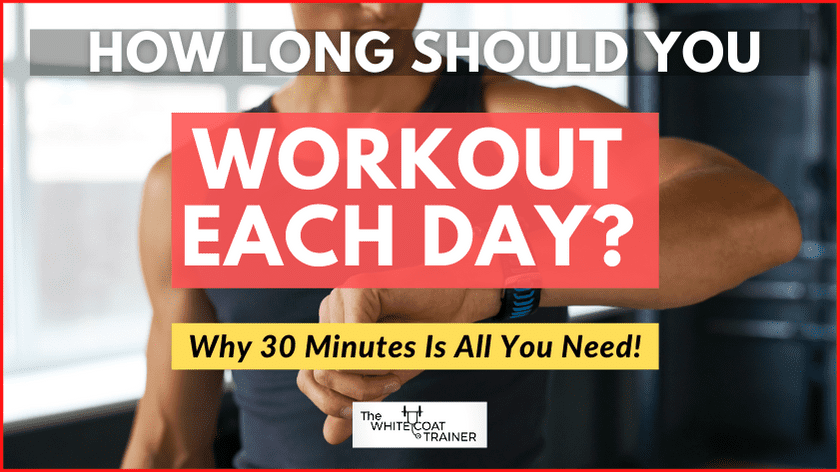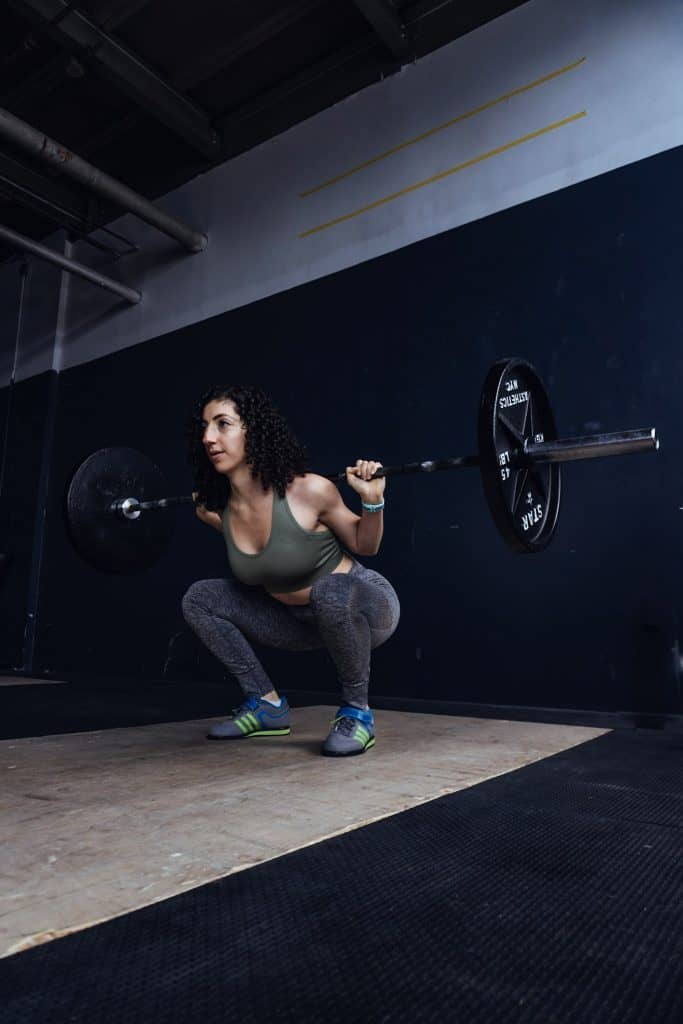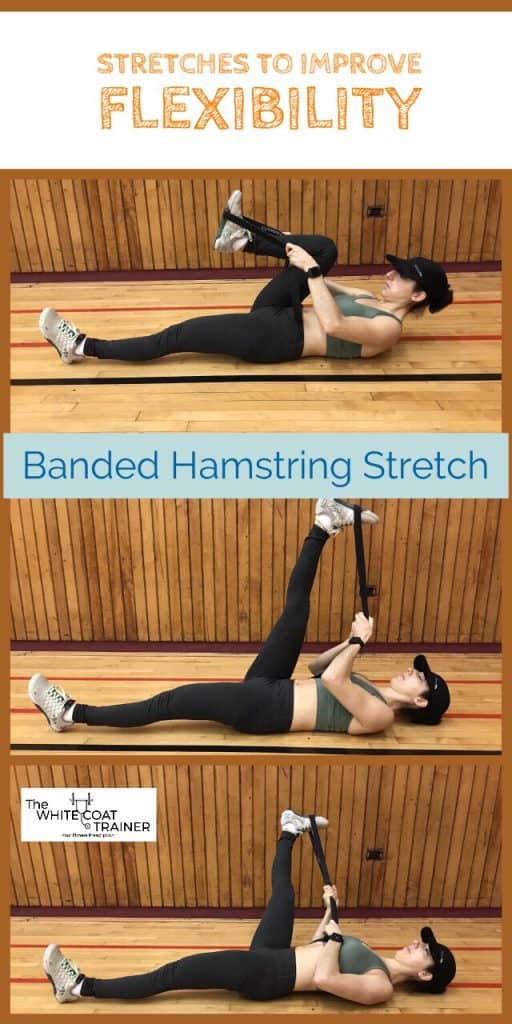How long should a workout be?
In today’s post, you are going to learn why 30 minutes is all you need.
I’ll also show you how to design your 30 minute training session for maximum efficiency.
Let’s dive right in.

This is one of the pillar posts in our series on How To Exercises Effectively and Efficiently.
How Long Should Your Workout Be?
Working out 30 minutes a day is a perfect sweet spot for both efficiency and consistency.
If done correctly, 30 minutes is plenty of time to build muscle, gain strength, and lose weight. With that said, 30 minutes is an average. Some workouts can be shorter, while others can be longer.
Three things you must consider are:
- the intensity of the workout,
- your current fitness level,
- and your training frequency.
The higher the workout intensity, the shorter it can be.
The more experienced you are, the longer your workouts can be.
Lastly, the more frequently you exercise, the shorter the sessions can be. (We discuss training frequency in How many days a week should I workout?)
Is A 30 Minute Workout Enough To Build Muscle?
30 minutes is enough time to build muscle if you 1) use the most efficient exercises, 2) challenge yourself appropriately, and 3) you implement progressive overload. It all starts with allocating your time appropriately, for the things that matter most.
First and foremost, don’t waste time on fluff exercises. You need to focus on large compound movements that recruit multiple muscles simultaneously. These functional movements include the:
- Squat,
- Hip Hinge,
- Horizontal Push,
- Horizontal Pull,
- Vertical Push, and
- Vertical Pull
Secondly, you need to make sure that your sets are sufficiently challenging. It is not necessary to go to failure, but you should push yourself to on each set. On a scale of 1/10, aim to give at least a 7/10 effort.
Finally, use progressive overload to gradually increase either the weight or reps every week. The more experienced you become with exercise, the more volume you can handle. I cover progressive overload in more detail here.
Short workouts help keep us motivated and have given us great results!

What If I Want To Do More? Is a 90 Minute Workout Too Long?
90 minutes is fine, as long as you can actually stick to 90 minute workouts. For many people, this is too much to fit into their busy schedule.
Your workout should only be as long as you can realistically handle on a weekly basis.
In other words,the best workout length will always be the one that you will follow.
In fitness, the length of your workout doesn’t matter if you can’t sustainably do it.
What Is An Ideal Workout Week?
I recommend that you focus the majority of your time on resistance weight training and improving your strength.
This includes 3–4 days of strength training lasting ~30-minutes each.
In addition, you should try to squeeze 1-2 aerobic sessions into your routine as well. This can be any form of light cardio such as:
- a brisk walk
- indoor cycling
- a light jog
- etc
So this is what your typical week may look like:
| Day | Workout |
|---|---|
| Monday | 30 Minute Strength Session |
| Tuesday | 30 Minute Strength Session |
| Wednesday | 15-30 minute aerobic session |
| Thursday | 30 Minute Strength Session |
| Friday | 30 Minute Strength Session |
| Saturday | 15-30 minute aerobic Session |
| Sunday | Off |
I always recommend that you take at least 1 rest day per week.
How To Design A ” Short Workout ” That is Effective & Efficient
In this next section, I will cover the 4 necessary components that your workout needs to be effective in 30 minutes.
A shorter workout ensures that you are focusing only on the stuff that matters while cutting out the fluff.
1) The Warm-Up Routine
First and foremost, it is essential that you warm up before any physical activity.
A warm-up is meant to do 3 things.
- Elevate your heart rate and body temperature,
- Activate the most dormant muscles in your body (namely the core and glutes),
- And stimulate the muscles you are about to use for the workout
You can go through a series of exercises or drills that can simultaneously do these three things at once.
My top recommendations include:
- Glute Bridges
- Plank Rows
- Lunges
- Banded Dislocations (Works best with these types of resistance bands)
- Squatting with a Band Around Your Knees (The Hip Circle works great for this)
A warm-up routine should not take you longer than 5-10 minutes.
Check out our complete guide on how to warm up properly to learn more.
2) Warm-Up Sets
The second component of your workout should be warm-up sets.
Please do not go to the gym, and load up the barbell with your working weight within 20 seconds of arriving.
Warm-up sets are critical for the first exercise of the day.
The first exercise of the day is the main movement, aka the most difficult exercise you are doing that day.
For example, you are squatting 135 lbs, you should do two warm-up sets.
- One with the empty barbell (45 lbs)…
- and the next set with 95 lbs.
The stronger you are, the more warm-up sets you will need.
As a beginner, the warm-up sets should not take you more than 5 minutes to complete.
3) The Main Exercise of The Day
After the warm-up sets, you should be at the working weight of your main exercise. Again, this is supposed to be a large compound exercise that trains more than one muscle group at a time.
Once you reach your working weight, you should have a good idea of how many sets and reps you need to accomplish.
If you do not know how many sets and reps you should do, check out our post on set/rep guidelines.
In addition, you should keep your rest periods strict. Long rest periods are unnecessary and increase the length of your workout needlessly.
As a beginner, the main exercise of the day should not take you more than 15 minutes to complete.
4) The Secondary Exercises
The remainder of the time you have left should be devoted to secondary exercises.
These exercises are not as intense as the first exercise and can be done with lighter weights such as dumbbells, or even your own body weight.
If you are strict, you can use this time to accomplish a lot of work in a little time.
You can do 2, or maybe even 3 secondary exercises if you are efficient.
This is where you will also build some aerobic fitness.
As a beginner, your secondary exercises should only take you 10-15 minutes to complete.
We break this all down in our article: How many exercises should you do per workout.
Bonus: The Cool Down
If you happen to have 1 minute leftover, you can also perform a cool-down.
I recommend that you do 30-60 seconds of 1 or 2 static stretches you desire.
Preferably, it should be related to the muscle groups you trained that day. The couch stretch is a great option for hip flexor stretching, and the chest and lat stretches are great for the upper body.

By far, the best book on stretching for athletes who do resistance training is Kelly Starrett’s Becoming A Supple Leopard.
In it, he covers hundreds of amazing stretches you can use anytime anywhere.
If you do not have time at the end of your workout, it is ok to skip this but do your best to incorporate it whenever you can.
So Here’s What Your 30-Minute Session Should Look Like
- Your pre-workout warm-up should take no more than 5 minutes (not included in the 30 min)
- Your warm-up for the main exercise of the day should take no more than 5 minutes
- The main exercise of the day should take you about ~10-15 minutes to perform
- Your secondary exercises should take you about ~10-15 minutes to perform
- Cool down for ~1 minute
Other Related Questions
How Long Should A Workout Be To Lose Weight?
You can lose weight working out 15, 30, 45, or even 60 minutes a day.
It all depends on the type of exercise, the intensity, and the workout duration. All kinds of exercise burn calories.
Important things to remember:
- The longer your workout, the more calories you will burn.
- The less time you spend resting during the workout, the more calories you will burn.
- The more intense the workout is, the more calories you will burn.
Working out will help you burn calories, but the bigger more important factor is calorie consumption.
You will never out-exercise excessive calorie intake.
If you want to lose weight, it is much better to improve your nutrition first before exercise.
What About High-Intensity Interval Training?
If you only have 10-15 minutes to exercise HIIT might be a good option for you.
Advantageous of HIIT
- You can do a lot of work, in very little time.
- Can help build muscle, burn fat, and improve aerobic capacity simultaneously
Disadvantages of HIIT
- It is really hard
- May not be suitable for beginners, as risk of injury is increased if you don’t use proper form
- Can be difficult to recover from
So how do you overcome these three disadvantages?
Let’s go over them one by one.
HIIT is very difficult
In order to reap the benefits of HIIT training, you must really push yourself. You often have to push yourself to the point where your heart rate is pounding and you are gasping for air.
The easiest way to begin implementing this into your training is to use short duration intervals. Something like 20 seconds. If 20 seconds is too hard, try 15. Slowly work your way up as you become stronger and fitter.
For example, you can do:
- 20-second sprint followed by 40 seconds of rest,
- Then 20 seconds of thrusters, followed by 40 seconds of rest
- Repeat this couplet for a total of 5 rounds
Mix and match the two exercises in the couplet as needed.
As your fitness begins to improve, slowly increase the duration of each interval, and decrease the rest time.
HIIT may not be suitable for beginners
Because HIIT requires you to move fast, it is easy to lose sight of proper technique. In order to overcome this, start off with exercises that do not require a high degree of technicality.
Start off with basic exercises such as bodyweight squats, mountain climbers, and up and down planks. As you begin to feel more comfortable, start increasing the difficulty of the exercises.
HIIT can be difficult to recover from:
This one is easy. All you have to do is take off at least 48 hours in between HIIT sessions. You can do this by following my recommendation above.
Just alternate each HITT session with a strength training session. In addition, you should choose exercises that won’t interfere with each other. For example, don’t choose a squat exercise as your strength training movement and then another squatting exercise for your HIIT session the following day.
Instead, alternate between an upper-body focused strength training session, and a lower-body focused HITT session and vice versa.
Is A 2 Hour Workout Too Long?
A 2 hour workout is too long for the vast majority of people. This is unsustainable and unrealistic for busy people who don’t have much time to exercise.
If you cannot stick to a consistent workout routine, then it won’t ever work.
It is much harder to consistently do longer workouts compared to shorter workouts.
How Long Does It Take To Transform Your Body From Fat To Fit?
You can develop noticeable muscle mass in as little as 6-8 weeks with a 30-minute resistance training program.
Noticeable weight loss can take anywhere from 6 to 12 weeks on a slow range or 4 weeks on a more aggressive plan.
By and large, the most important factor is consistency.
That is why you need a routine that you can realistically follow for 6-12 weeks!
A Simple 30 Minute Workout For Beginners You Can Start Today
So now that you know how long your workout should last, it is time to start designing your workout program.
This may take you several hours after you program the exercises, the sets and reps, the weight selection, and the progressive overload.
But why waste all the time when we did all the work for you?
The WCT Workout Template is a 15-week exercise program that tells you exactly what you need to do, and how to do it.
It is composed of full-body workouts using only the best types of exercises.
And yes, it is designed to have 30-minute workout sessions!
Check it out below.
A 15-week full-body program designed by two doctors for busy professionals. Build muscle and gain strength in just 30 minutes a day using only the most efficient exercises and training protocols.
The Bottom Line On How Long You Should Be At The Gym
Don’t forget- the duration of your workout only needs to be as long as you can realistically handle.
The optimal workout length will always be the one that you can follow.
So to recap:
- Beginners should workout 30 minutes a day, at least 4x per week
- Focus on one primary exercise per individual workout session
- The primary exercise should be one of the big compound exercises
- Add 1-2 aerobic activities (or High-intensity intervals) to your weekly routine
Now I want to hear from you.
How long do you typically work out?
Comment below and let us know!
Related Posts On Building Muscle:
- How Many Sets and Reps Should I Do?
- What Exercises Should I Include In My Program?
- How To Create The Perfect Workout Program

Alex Robles, MD, CPT / Brittany Robles, MD, MPH, CPT
Alex & Brittany Robles are physicians, NASM Certified Personal Trainers, and founders of The White Coat Trainer: a resource dedicated to improving the health and fitness of busy professionals using time-efficient strategies. Their advice has been featured in My Fitness Pal, Prevention, Livestrong, Reader’s Digest, Bustle, The Active Times, and more. Learn more about them here.


You guys are incredible. Your training articles are some of the best I’ve read and I really appreciate the organized stepwise approach you take to present this important information. It is teaching and coaching at its best. New insights and guidelines to keep my exercise regimen
efficient and productive. Thanks!
Thank you for the kind words Marc. What other topics would you like to see covered?
Do you have any baseline level of aerobic health that you think everyone should aim for? 15 minutes seems like enough time if you are just kind of looking to maintain an aerobic fitness level but not enough to really improve it much. Something kind of like the article you did on strength standards.
That would be a good article. I think 15 minutes of direct aerobic work (moderate to high intensity) in addition to forcing yourself to do secondary exercises quickly (with an elevated heart rate and low rest periods) would improve aerobic fitness in beginners or those who are starting from a low baseline. It probably wouldn’t be enough to increase the aerobic capacity in someone who is already fit. But I think many of us only need just enough aerobic fitness to gain health benefits, and any more would be just for competitive sake. I will look into definitely look into standards.